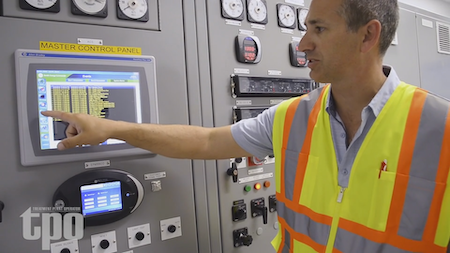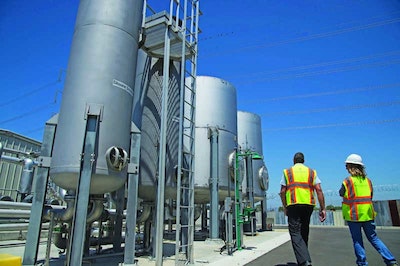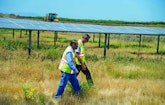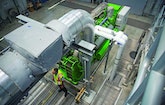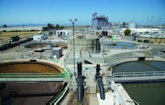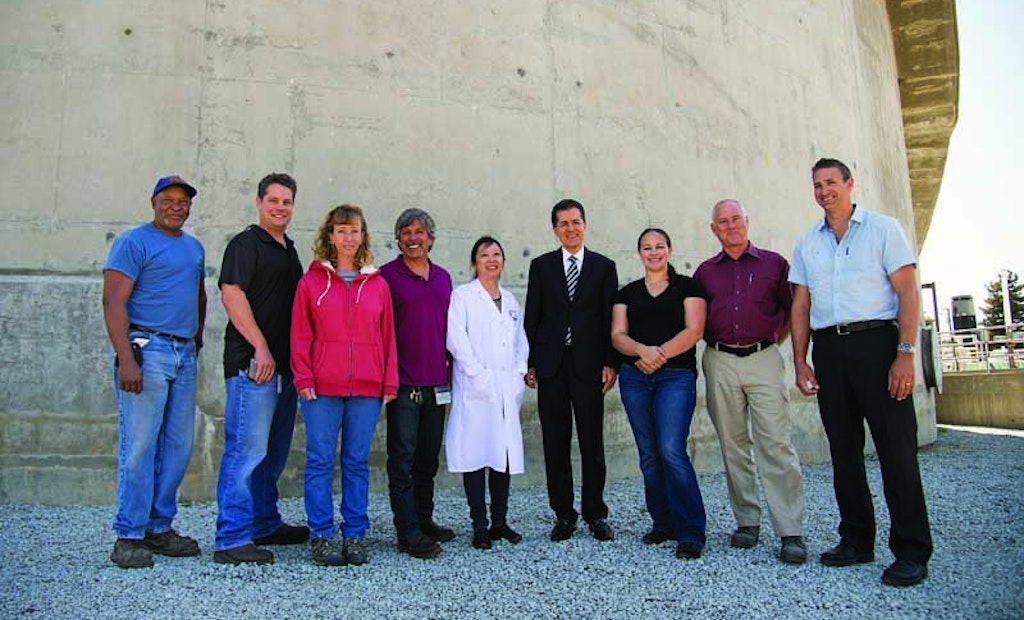
Interested in Engineering/Consulting?
Get Engineering/Consulting articles, news and videos right in your inbox! Sign up now.
Engineering/Consulting + Get AlertsThe Hayward Water Pollution Control Facility used to consume up to 60 percent of the city’s electricity. Today, it produces its own and exports enough energy to supply a significant share of the power for the water and sewer pumping stations, and for City Hall.
The facility is unplugged, according to Jeff Carson, operations and maintenance manager.
It fulfills 100 percent of its power needs through cogeneration using digester gas while generating a 38 percent surplus available for other city facilities. A 1 MW photovoltaic solar array generates even more electricity, which is exported to the local power grid.
The city, sixth largest in the San Francisco Bay Area of California, plans to add more cogeneration and solar capacity within the next two years, doubling the plant’s power output. “We currently supply power to 22 external accounts,” says Carson. “As we refine the process and increase our green power production, we will be able to export to more accounts.”
And Carson’s “unplugged” reference? “I remember old MTV videos of vocal groups that used no electric instrument. The music was called ‘unplugged,’ and I thought that was an appropriate description of our plant. The average person may not understand our processes but can picture us unplugged from the power grid.”
Efficient process
The Hayward Water Pollution Control Facility was started up in 1952 and occupies 300 acres on the city’s southwest side. It serves the city of Hayward and its 150,000 residents. Average daily flow is 11.3 mgd; design capacity is 18.5 mgd.
The facility uses trickling filters at the head end to remove the majority of CBOD. This is followed by the headworks and primary clarifiers. Low-load suspended growth treatment is provided by a solids contact process before the secondary clarifiers.
Using actuators from REXA and instruments from YSI, a Xylem brand, the plant staff controlled the airflow and reduced aeration blowers from 2 1/2 operating at 200 hp to just one operating at 200 hp. It’s one of many measures taken to increase energy efficiency.
“On average, we had 2 1/2 out of three blowers running all the time,” says Carson. “We grouped all the ideas together, selected the best and took that concept to our electricians. Our instrumentation wasn’t tight enough for the process. We refined the PLC mode of operation, and in the end we have one blower running in steady-state operation. We’ve experienced a significant savings in electricity.”
Clarified effluent is disinfected with sodium hypochlorite and then sent to a regional dechlorination facility before released to San Francisco Bay. The plant has not had a permit violation in more than 10 years and averages more than 97 percent CBOD and TSS removal.
The plant also sends up to 4.5 mgd of treated effluent to the Calpine-Russell City Energy Center, a 619 MW natural-gas-fired power facility next to the plant. The effluent reduces the center’s potable water requirements, and the Hayward facility saves about 20 percent on effluent pumping costs.
Biosolids are thickened to 5.5 percent solids on a pair of gravity belt thickeners (BDP Industries) and then fed to three 3.48 mgd anaerobic digesters on a digester feed schedule. The solids are mixed with fats, oil and grease, and scum from the clarifiers in what Carson calls “our secret recipe for success.”
The mixing occurs in the feed pipeline, and solids are switched back and forth between digesters 1 and 2 before being sent to digester 3. Digester overflow, averaging 90,000 gpd, is sent to solar drying beds. The biosolids are used for landfill cover, although expected regulations in California may prevent that practice in the future. “We are looking at options,” says Carson.
Pumping out power
Biogas from the digesters process fuels the cogeneration system, which was designed by Carollo Engineers and commissioned in 2014, replacing two older units. The gas is scrubbed in a treatment process and then routed to a Jenbacher JGS416 engine. The engine is linked to a 70 percent efficient generator. Waste heat provides up to 3.4 million Btu/hour to the hot-water loop.
The biogas can be blended on the fly with natural gas as needed. The blend rate is below 7 percent natural gas, and occasionally the cogeneration unit runs on only biogas for several weeks with outstanding results.
In addition to FOG from restaurants and other establishments, Hayward accepts milk waste from Berkeley Farms and spent product from a biodiesel process. The quality of feed to the digesters is key. “The material can be inconsistent,” Carson says. “We sample all along, trying to determine what’s good and what’s not. We try to find the happy medium and the most consistent vendors of the material.” A FOG storage tank helps smooth out the feed quality.
Close monitoring of the cogeneration process is also critical. “We typically run on blended mode at maximum engine output,” says Carson. “During commissioning, we ran in plant demand mode to minimize natural gas usage. The cogeneration unit also shuts off if power export rises above a certain level, due to current tariff setpoints.” On average, cogeneration produces 750,000 to 800,000 kWh per month, topping total plant usage of 700,000 kWh and producing the excess that can be exported.
The solar field, added in 2010, generates additional power for export directly to the Pacific Gas & Electric (PG&E) utility grid, tying in directly to the plant’s bus bar main breaker. The panels are from REC Solar, which also maintains the installation and uses its global clock so that the array follows the sun.
While the generation system ranks 21st on U.S. EPA’s list of the top 30 installations generating green power, the plant team is shooting for more. “We’re making adjustments to supercharge the digestion process and significantly increase the production of gas,” Carson says.
The improvements include adding automated valves, doubling the size of the FOG blending tank, updating the biogas burner to handle more gas production, and upgrading all feed lines for more clarity. If these efforts are successful, Carson says plans will move ahead to add a second cogeneration unit.
“The second cogeneration pad is already in place,” says Carson. “That will facilitate tie-in. The city’s goal is to be at zero energy consumption by 2020.” A second solar array identical to the first is being financed, and land is being prepared for panel structures.
Excellence through
Cogeneration is no slam dunk. Carson says the tie-in of the generation system with the rest of the plant was complex: “You’re dealing with switchgear and boiler loops, as well as power engineers, PG&E, and your own internal staff. In addition, the state air quality board has stringent requirements. You need to train your wastewater experts to become energy experts. They need to know how to run the system after-hours, to bring the system back online.”
Carson and the entire Hayward team met with vendors to learn about the equipment. Maintenance personnel were first sent off to training in Wisconsin, after which they refined the control setpoints, reviewed all the equipment, and monitored what they needed to know to maintain the desired cogeneration system performance. Facility staff conducted process area training, using multimedia standard operating procedures, videos and online monitoring. Critical event training focused on wet-weather power restoration. Training was provided for operators, mechanics, electricians and laboratory staff.
The simplified SOPs helped. “We developed easy-to-follow SOPs on how to use the cogeneration system and how to restart it if it got knocked offline,” says Carson. The documents include a clear list of definitions, personnel responsibilities and safety instructions. They outline the restart procedure in several succinct sentences, accompanied by control panel photos.
Training is high on the list of recommendations Carson makes for wastewater facilities contemplating green power generation. “Staff is your main resource,” he says. “They’re critical. You have to think of staff in order to be successful.”
Beyond that, he suggests going back to the original facilities plan: “Start with digestion and biosolids handling. Do an energy audit and monitor your electrical usage. Find out when it’s intensive and when it’s not. Get the design right, involve your operators and maintenance personnel, and look for available grants in your area.”
Under the leadership of Alex Ameri, director of utilities and Public Works, Hayward has replaced its original cogeneration unit and installed the first solar array to shave demand in the face of an ever-increasing energy bill. “He got the grants,” says Carson. “He had the vision.”
Today, the city has an aggressive Climate Action Plan and has been awarded the 2015 California League of Cities Silver Beacon Award for reducing greenhouse gases. “Global leaders have crafted plans to reduce our carbon footprint,” says Carson. “Energy-efficient wastewater treatment plants can help make a better planet. Imagine if all 14,700 wastewater plants in the United States were unplugged.”
Exemplary facility
As its green power production goes up, honors keep coming in for the Hayward Water Pollution Control Facility. It was named 2015 Plant of the Year by the San Francisco Bay Section of the California Water Environment Association (CWEA).
The U.S. EPA bestowed its Green Power Leadership Award for generating up to and over 130 percent of the plant’s energy needs. Hayward was also one of four California cities honored with the 2015 League of Cities Silver Beacon Award in 2015 for reducing greenhouse gas emissions, saving energy and adopting policies and programs that promote sustainability.
Jeff Carson, operations and maintenance manager, was named an emerging leader by CWEA. “He’s the project coordinator for process optimization,” CWEA board member Gayle Tupper wrote in the nomination form. “He solicits staff input, researches the project, and collaborates with managers and engineers for ongoing improvements. As a coach, he focuses on learning and improvement of plant processes and performance.”
The plant is a destination for professionals eager to learn more about the waste-to-power process. “Many people visit and are interested in our combination of cogeneration and solar processes,” says Carson. “Our engineering staff, along with operations and maintenance, are at the top of their game and contributing exceptional improvements.”
Carson has found enough interest to form a cogeneration user group in the Bay Area to discuss such topics as operations, maintenance and air quality.
